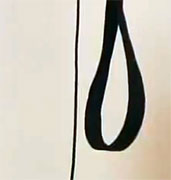
TUESDAY, Nov. 20 (HealthDay News) — A surge in hanging deaths among middle-aged adults appears to be responsible for the notable increase in U.S. suicides between 2000 and 2010, a new study finds.
Hangings accounted for 26 percent of suicides in 2010, up from 19 percent at the start of the decade. Among those aged 45 to 59, suicide by hanging increased 104 percent in that time period, according to the report documenting changing suicide patterns.
Overall, 16 percent more Americans took their own lives in 2010 than in 2000. That’s equivalent to 12.1 suicides per 100,000 people compared to 10.4 per 100,000 previously.
“It is important that the huge increase in suicide by hanging be recognized,” said lead researcher Susan Baker, founding director of the Johns Hopkins Center for Injury Research and Policy at the Johns Hopkins Bloomberg School of Public Health in Baltimore.
Greater public awareness and education about death by hanging are needed to help stem the suicide rate overall and this particular method, she and other experts said.
“People may think that death by hanging is immediate and painless, but people struggle . . . I am sure it is not painless by any means,” Baker said.
For the study, published in the December issue of the American Journal of Preventive Medicine, Baker’s team used data from the U.S. Centers for Disease Control and Prevention.
Guns are still the number one method of suicide. Guns, poisoning and hanging account for 93 percent of all suicides in the United States, Baker’s group found. Although suicide by firearms dropped almost one-quarter among 15- to 24-year-olds, it rose by almost the same amount among those aged 45 to 59.
Suicide by poisoning increased to 17 percent of all suicides, up from 16 percent in 2000. Self-inflicted death by poisoning increased most (85 percent) among people aged 60 to 69 years, the investigators found.
Other trends the researchers noted:
- Suicide rates are increasing faster among women than men, and faster among whites than in non-whites.
- In terms of age, the suicide rate increased the most (39 percent) among people 45 to 59, while dropping 8 percent among those 70 and older.
A recent paper in the same journal reported that more people die by suicide in the United States than in car crashes, making suicide the leading cause of injury deaths.
A report published Nov. 5 in The Lancet said about 1,500 more suicides have occurred since 2007 than expected, and it attributed about one-quarter of the increase to the sagging economy.
Baker said limiting access to guns and narcotic painkillers has helped reduce suicides involving those methods, and she wants to see similar strategies adopted to limit opportunities for hanging.
For example, building codes can ensure that overhead light fixtures and pipes are unable to support the weight of a person, she said.
And clothing bars in closets should be made to break away when excess weight is placed on them, Baker said.
However, limiting access to hanging is far more difficult than limiting access to guns or poisons, experts said.
“These new findings pose a serious challenge for injury prevention efforts due to the widespread availability of rope and other means for hanging,” said Simon Rego, director of psychology training at Montefiore Medical Center in New York City.
Lanny Berman, executive director of the American Association of Suicidology, agreed.
“This shift will require innovative efforts by those in the suicide prevention community and by policy makers to effectively reach the desired goals of the revised National Strategy for Suicide Prevention,” Berman said.
That program was recently infused with a $56 million federal grant to fund suicide prevention programs. The goal is to save 20,000 lives in the next five years.
With the exception of the United States, hanging has been the number one method of suicide in high-income countries worldwide, Berman said.
More information
For more information on suicide, visit the U.S. National Library of Medicine.

